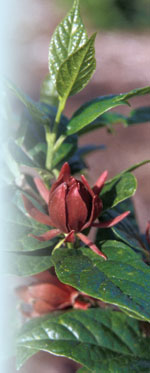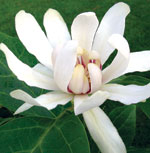Sweetshrub Provides Alluring Fragrance, Subtle Charm
go.ncsu.edu/readext?235966
en Español / em Português
El inglés es el idioma de control de esta página. En la medida en que haya algún conflicto entre la traducción al inglés y la traducción, el inglés prevalece.
Al hacer clic en el enlace de traducción se activa un servicio de traducción gratuito para convertir la página al español. Al igual que con cualquier traducción por Internet, la conversión no es sensible al contexto y puede que no traduzca el texto en su significado original. NC State Extension no garantiza la exactitud del texto traducido. Por favor, tenga en cuenta que algunas aplicaciones y/o servicios pueden no funcionar como se espera cuando se traducen.
Português
Inglês é o idioma de controle desta página. Na medida que haja algum conflito entre o texto original em Inglês e a tradução, o Inglês prevalece.
Ao clicar no link de tradução, um serviço gratuito de tradução será ativado para converter a página para o Português. Como em qualquer tradução pela internet, a conversão não é sensivel ao contexto e pode não ocorrer a tradução para o significado orginal. O serviço de Extensão da Carolina do Norte (NC State Extension) não garante a exatidão do texto traduzido. Por favor, observe que algumas funções ou serviços podem não funcionar como esperado após a tradução.
English
English is the controlling language of this page. To the extent there is any conflict between the English text and the translation, English controls.
Clicking on the translation link activates a free translation service to convert the page to Spanish. As with any Internet translation, the conversion is not context-sensitive and may not translate the text to its original meaning. NC State Extension does not guarantee the accuracy of the translated text. Please note that some applications and/or services may not function as expected when translated.
Collapse ▲
‘Michael Lindsey’
Thomas G. Ranney ©
Calycanthus, commonly known as sweetshrub, sweet bubby or simply calycanthus, is a favorite of many gardeners. An old-fashioned deciduous shrub, it has been overlooked in recent history but is now making a comeback. It is best known for maroon-red fragrant flowers that open before the leaves emerge in the spring. People in the know plant sweetshrubs around patios or decks where they can enjoy the strawberry-scented aroma.
Sweetshrubs are easily transplanted and can be grown in sun or shade. They can get tall and leggy, growing 6 to 9 feet tall, but pruning after flowering will keep them presentable. They prefer a deep, well-drained loamy soil, though they are tolerant of less-than-perfect soil conditions. Sweetshrubs are tough plants, having few insect or disease problems.
One species of calycanthus is native to North Carolina. The Carolina sweetshrub is commonly found growing as an understory shrub in woodlands and along streams. Sweetshrub can be propagated by seed, but some seedlings may not be true to type and may not have fragrant flowers. Softwood cuttings taken in late spring and summer and treated with a rooting hormone will root readily for most cultivars.

‘Venus’
Thomas G. Ranney ©
Varieties such as ‘Hartlage Wine’, ‘Athens’ and ‘Michael Lindsey’ are good choices for different flower colors and improved fall color. New hybrids are being developed at NC State University using a combination of different calycanthus species. One of the most promising varieties is a selection called ‘Venus’ produced by crossing three different species. ‘Venus’ produces large, ivory yellow buds on a medium-sized shrub. These buds open into large, upright white flowers that resemble a magnolia bloom. The spring blooms are very fragrant and much showier than the native sweetshrubs. ‘Venus’ is now being propagated by several commercial nurseries and will be available to the gardening public shortly. Hold a spot in your garden for ‘Venus’. It will be worth the wait.
Mark Danieley


